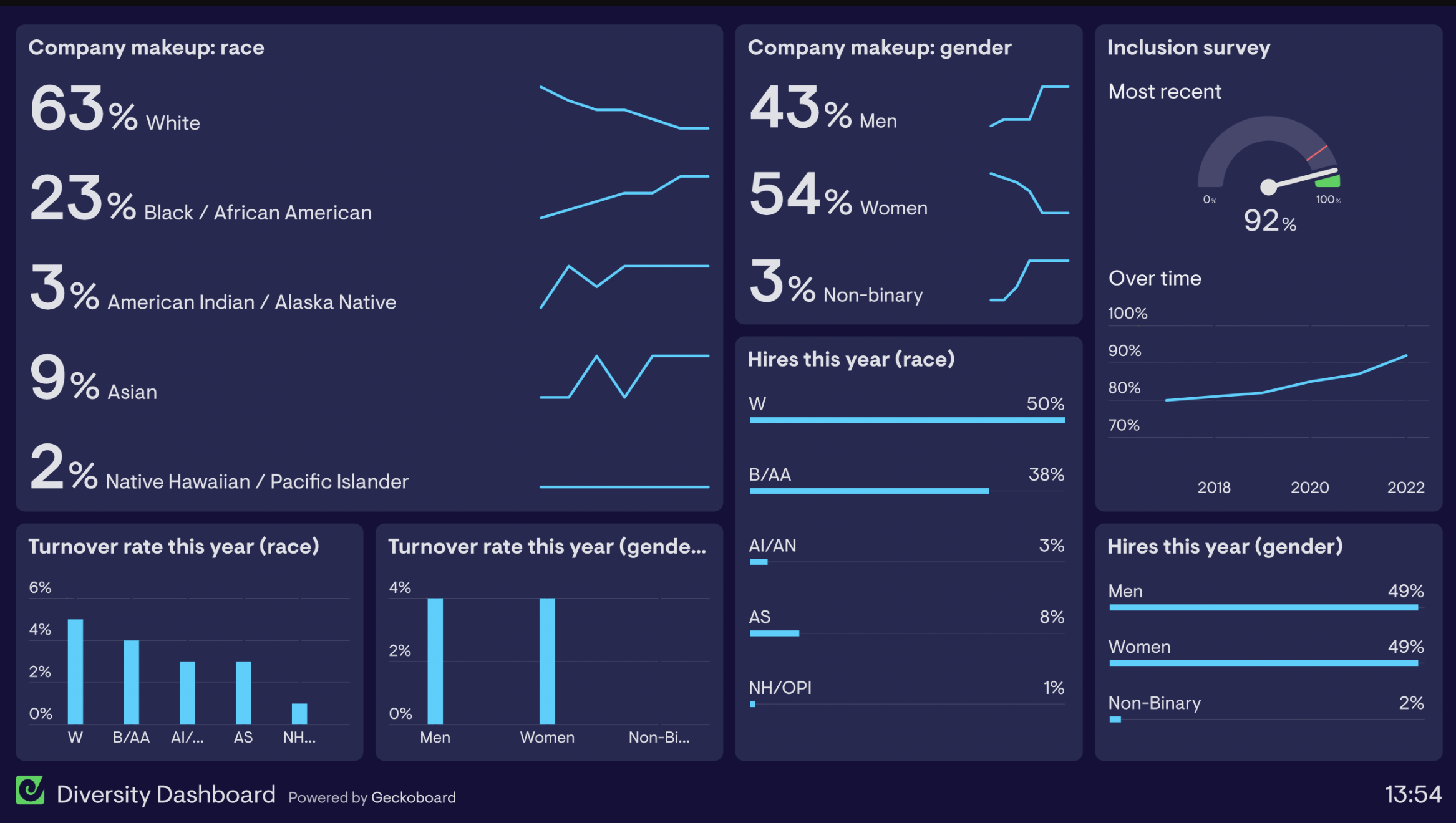5 min. read
How to Create a DEI Scorecard
5 Steps to Evaluate Workforce Diversity & Downloadable Template
The perfect DEI scorecard doesn’t exist but it can be created.
Unfortunately, you won’t find a perfect DEI scorecard on Google because a generic tool won’t reflect your organisation’s values, pace of change, or DEI maturity – but there is a way to tailor one to your needs.
While organisations stress the importance of DEI at work, the challenge is how to measure it quantitatively. That’s where the scorecard comes in.
What is a DEI scorecard?
Creating an effective diversity scorecard can be challenging but these steps will help ensure it accurately measures progress toward your organisation’s DEI goals.
1. Assess Current DEI Status
The first step is to understand your organisation’s current standing in terms of diversity, equity, and inclusion. This involves gathering and analysing data related to your workforce demographics, pay equity, and representation at various levels.
Why?
Assessing the current DEI status provides a baseline against which progress can be measured. Without knowing where you currently stand, it is impossible to set realistic goals or track improvements effectively.
Example: Conduct an internal audit to gather data on the current number of women in tech roles, pay equity, and representation of women at different levels within your tech department.
2. Define DEI Goals
Once you have a clear understanding of your current DEI status, the next step is to set specific, measurable, achievable, relevant, and time-bound SMART (specific, measurable, attainable, relevant and time-based) goals. These goals should address the gaps identified in the assessment phase and align with your organisation’s overall strategic objectives.
For example: increase the number of diverse candidates applying for jobs / develop an internship vacancy for marginalised groups / set up a career changers program / establish internal promotion plans / create an executive sponsorship program / launch 1 ERG per quarter.
Important! Assign accountability. Hold leaders accountable by assigning specific, time-bound DEI goals with clear consequences. Ensure metrics are ambitious yet realistic, specific, and time-bound.
Why?
Clear goals provide direction and focus for your DEI initiatives. They help ensure that efforts are targeted and that progress can be objectively evaluated.
Example: Set a goal to increase the percentage of women in senior tech roles by 15% over the next three years or to achieve a 20% increase in female applicants for tech positions within two years.
3. Select Key Metrics
To measure progress toward your DEI goals, you need to identify specific metrics. These metrics should be directly related to your goals and provide quantitative data on various aspects of diversity, equity, and inclusion within your organisation.
Important! Determine the pace of change. Set an ambitious yet realistic timeline, considering competing priorities, staffing, leader buy-in, and industry trends. For example, if aiming to increase female senior leaders by 30% in 2 years, ensure you have a pipeline of talent at lower levels first.
Why?
Selecting the right metrics ensures that you are measuring what matters most to your DEI objectives. This allows for accurate tracking and assessment of progress, helping to identify which initiatives are effective and which need adjustment.
Example: Choose metrics such as the percentage of women hired for tech roles, the retention rate of women in tech, the number of women promoted to senior tech positions, and survey results on women’s experiences in the tech department.

4. Develop the Scorecard
Create a visual tool, such as a dashboard (see right), that tracks and displays your selected metrics over time. This scorecard should be easy to interpret and provide a clear overview of your organisation’s progress toward its DEI goals.
Why?
A visual scorecard makes it easier to communicate progress to stakeholders and can highlight trends and areas needing attention at a glance. It serves as a central reference point for tracking DEI initiatives.
Example: Use software like Power BI or Tableau to create a dashboard that visually represents these metrics. Include graphs showing hiring trends of women in tech, female representation in senior tech roles, and survey responses on workplace inclusion for women in tech.

5. Regular Reviews
Establish a schedule for regularly reviewing the scorecard and evaluating progress. These reviews should involve key stakeholders and decision-makers and should be used to make necessary adjustments to strategies and goals.
Important! Enable leaders, managers, and support systems. Prepare stakeholders with training on unconscious bias, inclusive leadership, and DEI strategies. Ensure supporting teams, including legal, compliance, and communications, are aligned and equipped to assist in achieving DEI goals.
Why?
Regular reviews ensure that DEI efforts remain a priority and allow for timely adjustments to strategies. They help keep the organisation accountable and responsive to any issues or opportunities that arise.
Example: Schedule quarterly meetings to review the scorecard with senior leadership. Discuss areas where the organisation is meeting its DEI goals for women in tech and identify areas needing improvement. Adjust strategies based on these insights.
Who should be using the DEI scorecard?
A DEI scorecard is a vital tool for various stakeholders within an organisation to ensure progress toward diversity, equity, and inclusion goals. Here’s a breakdown of who should be using the DEI scorecard and why:
Senior Leadership
Senior leaders need to understand the organisation’s DEI progress to align it with overall business strategy. Their involvement underscores the importance of DEI initiatives and ensures that they receive the necessary resources and attention.
Example: The CEO uses the scorecard to report DEI progress to the board, ensuring that DEI goals are integrated into the broader organisational strategy.
HR and DEI Teams
These teams are directly responsible for implementing DEI initiatives and need detailed insights into the current status and effectiveness of their efforts. The scorecard helps them identify areas for improvement and plan future actions.
Example: The HR team uses the scorecard to track hiring and retention metrics, ensuring that recruitment strategies are effectively increasing diversity within the tech department.
Managers and Department Heads
Managers are critical to the day-to-day implementation of DEI practices. They need to understand their department’s progress to foster an inclusive environment and address specific DEI challenges within their teams.
Example: Tech department heads use the scorecard to monitor the gender diversity within their teams and to ensure that women are being promoted and retained at comparable rates to their male counterparts.
Employees
Transparency in DEI efforts fosters a sense of trust and accountability within the organisation. When employees can see the progress being made, it can increase engagement and support for DEI initiatives.
Example: Members of a women-in-tech ERG use the scorecard to advocate for specific changes and to track how their input is being addressed by the organisation.






